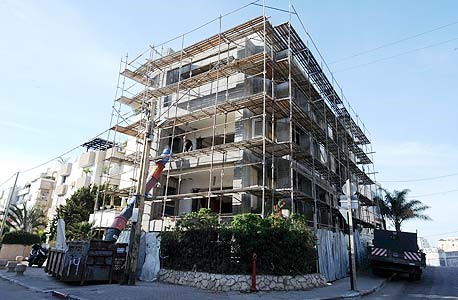Calcalist, Adv. Ziv Grumman, 11.10.20
In November 2019, the National Planning and Building Council announced that NOP 38 - the National Outline Plan for Strengthening Existing Buildings Against Earthquakes - would officially end its path in October 2022, putting the players of urban renewal on alert.
Although the plan was approved by the Israeli government as early as 2005, it was only in 2012 that it began to establish a foothold in the local construction landscape - with the approval of Amendment 3, according to which the addition to the reinforcement route 25 square meters and closing the floor of the columns. This is actually the significant landmark in the history of the program, and therefore when considering its effectiveness, it should be done in the perspective of 8 years and not 15 years.
Without going down too much in resolutions, it can already be said that despite its good intentions, and everyone will surely agree, TAMA 38 failed to reach the periphery and especially those at risk settlements located on the Syrian-African rift - including Tiberias, Beit She'an, Kiryat Shmona, Rosh Pina and Safed The inability to produce an economic formula that would bring entrepreneurs to the book areas, led to the projects draining the vast majority of them to the demand areas - Gush Dan, the Sharon and the surrounding area.
There are quite a few failures in NOP 38, one of the main ones being the discretion given to local committees under section 22 of the NOP provisions, which led to an intensive change in policy documents - not only at the end of election campaigns and the replacement of heads of authorities, but often Terms. It is not disputed that updating the policy and adapting it to the spirit of the time and reality on the ground is essential, but that such a step also requires a response to projects that have already come a long way under the previous policy, and in the wake of a decision found themselves completely helpless.
Cracking is required
Either way, whereas just two years the program's mandate expires, when the fog trying Currently dissolve the legislative memorandum alternative plan 38, the formulation is working now planning administration, teaching interior minister Aryeh Deri. It is important to emphasize that this is not a finished document, but one that still Is in intra-office coordination work and has not yet been published for public comment , but it is still possible to get a snapshot of the guidelines.
Even before examining the proposed principles, I believe that as long as the alternative plan has not yet been implemented and has not been formulated definitively, the abolition of the NOP is a hasty move, to say the least. The alternative), during which the practical application of the alternative outline will be examined - and as long as it does meet its objectives and really meets reality, it will be possible to shelve the NOP in a final and absolute manner.
It is important to emphasize that the integration of the alternative outline in legislation within the framework of the Planning and Building Law is a welcome matter, which at a good time will produce the certainty that is so required in the field of urban renewal. However, in the memorandum of law in its current form I do not find a reference to the issue of capital gains tax and VAT - of which, as is well known, NOP 38 projects are currently exempt (under the conditions set forth in the Real Estate Tax Law and VAT Law, as applicable). There is no economic viability for ventures in the field, and projects will not be launched.Therefore, a comprehensive approach is required that will dispel the fog around these issues.
 TAMA 38 project in Givatayim. "It is appropriate to include a defined period of overlap between the plan and the alternative outline" Photo: Yuval Chen
TAMA 38 project in Givatayim. "It is appropriate to include a defined period of overlap between the plan and the alternative outline" Photo: Yuval Chen
The principles of the new law require the addition of a standard-sized 12-square-meter security room, with any additional addition open to discussions between the apartment owners and the developer - and naturally depends on the scope of building rights as well as the profitability of the project. According to the memorandum of law in projects in the strengthening and thickening route, an additional building rights of 200% are proposed, while in buildings that include a pillar floor, this will be closed in favor of the establishment of commercial and public areas. On the other hand, in demolition and reconstruction projects, an additional 350% building rights will be allowed, along with the construction of office space and the allocation of public areas.
The allocation of land for the benefit of the public is in a line of considerable community value, but even around this important issue there are currently quite a few question marks. From the starting point of the project, will the tenants know what will be built under the house and what is the purpose of the public areas? What weight (if any) will they have in decision making? It is clear that building a kindergarten, school or milk drop branch is not the same as setting up a drug addiction rehabilitation center or building a public parking lot. Another issue that requires attention concerns the allocation of office space, an industry that in the days of the Corona is undergoing a difficult upheaval. In the current reality, are offices also a required product? Really not sure.
And back to the issue of the periphery, in the principles of the memorandum of alternative law I have a hard time finding the economic crackdown that will attract urban renewal projects even beyond the center of the country. The law of Tel Aviv is not the law of Beit She'an or Yeruham, and therefore all the districts and cities must not be treated as one piece. At this stage I do not see exactly how the alternative plan will change the existing situation and lead to the realization of projects in the periphery as well. Still, if today it is not economical for developers to start projects with building rights in the amount of 250% -300%, why would it be profitable for them to promote projects in the amount of 350% that need to set aside public areas or pay an improvement levy? In the end, a volume multiplier will not solve the situation.
 Adv. Ziv Grumman. Include in the alternative law also effective tools for combating reluctant tenants
Adv. Ziv Grumman. Include in the alternative law also effective tools for combating reluctant tenants
Entrepreneurs in the framework of urban renewal, which have already been well internalized by those involved in the craft, are long-distance running that requires patience and long-suffering, while in the best tradition, the new law is still expected to be changed and adjusted. What is certain is that in a country characterized by a large number of buildings erected decades ago, the goal is first of all to renovate and protect them, no matter under what plan and what its name is.
The legislature would do well if, in addition to preparing a quality alternative, it would also provide effective tools for combating reluctant tenants, including lowering the required majority in projects from 80% to 66%. A recommendation in this spirit regarding the reduction of the threshold of agreements in eviction-construction has already been presented in a report by the Ministry of Justice and the Government Authority for Urban Renewal from last April, and it must be adopted (and promoted in legislation) in demolition and reconstruction projects. Praise and VAT Construction services will give a real boost to the field of urban renewal and will be translated in the field for a significant expansion of the number of projects.
The author is the founder and owner of the law firm of Grumman & Co. , which specializes in real estate and accompanies and advises on hundreds of urban renewal transactions.



